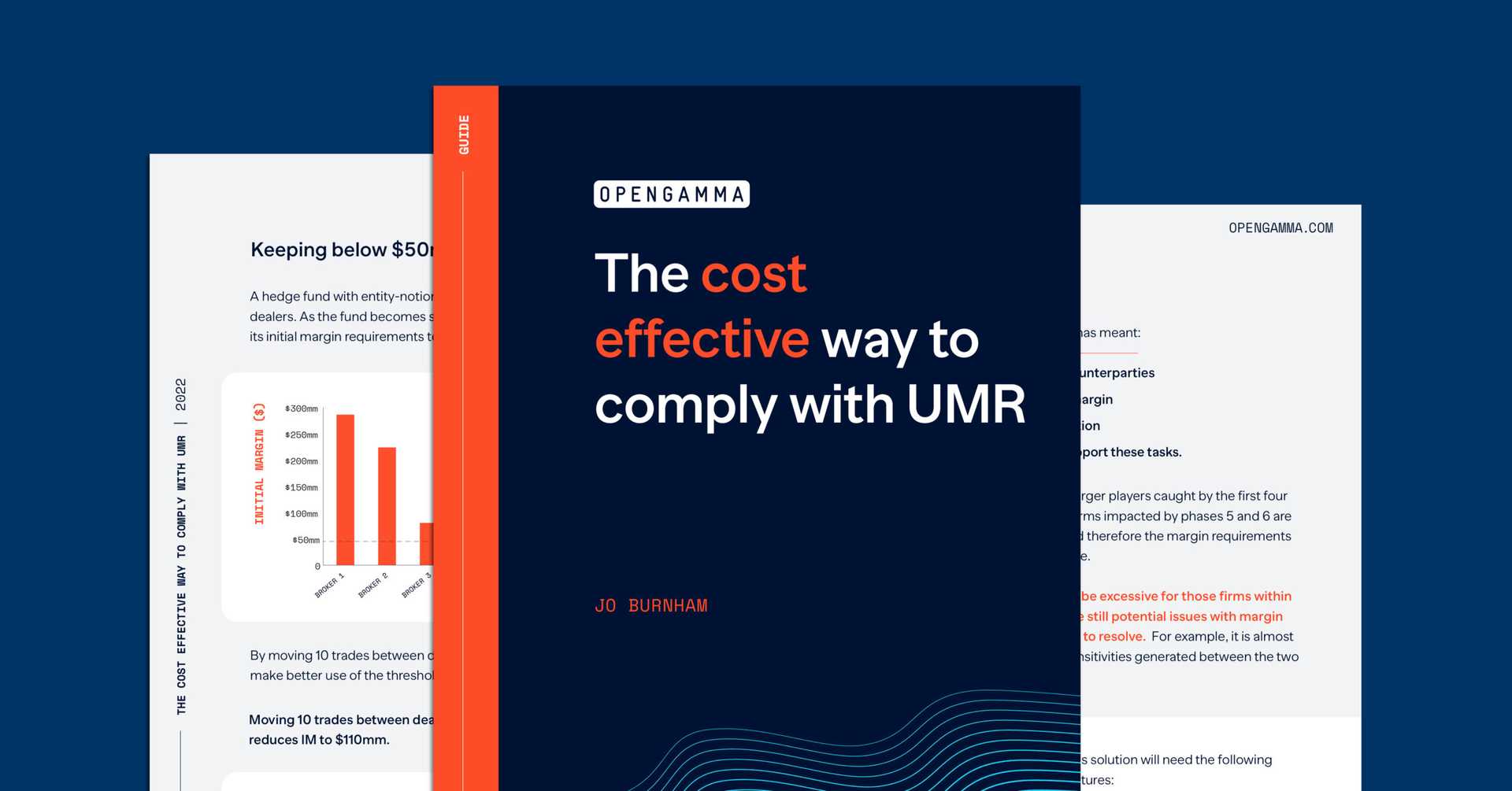This article first appeared in the HFM Billion Dollar Club 2019 Special Report.
With only a few months to go before the introduction of the Uncleared Margin Rules (UMR) Phase 4 on 1 September, and with Phase 5 arriving in September 2020, we have been working with a number of firms to help them with the necessary preparation tasks. There were less than 50 market participants impacted by Phases 1 to 3, but with the introduction of Phases 4 and 5, dealers could face over 1,000 newly in-scope counterparties (NISCs) and over 9,000 new relationships.
What we have learnt is that there is still a lot of work to be done to meet the requirements and a lot of decisions to be made on the best way forward. And then there are the practical issues to contend with, in particular the fact that calculating SIMM is a complex problem which may be easily overlooked at the outset. The challenges involved are not to be underestimated, and the impact that modelling differences can have on Initial Margin calculations can be significant. These differences, which affect operational processes and lead to potential disputes, will need to be resolved.
Background
The UMR was introduced by the BCBS and IOSCO in 2016 as one of the two major reforms to mitigate systemic risk in the industry following the 2008 financial crisis. In addition to the introduction of clearing for standardised OTC instruments, regulators set out to increase the requirements for trading non-centrally cleared derivatives by enforcing the exchange of Variation Margin and Initial Margin for bilateral trades.
Uncleared margin rules apply to all financial firms and systemically important non-financial firms. The rules have been capturing firms from various phases over the last 3 years and those with a notional exposure above $8bn of bilateral derivatives will be familiar with the exchange of Variation Margin already. However, Initial Margin may well be a new concept for a lot of firms.
[bctt tweet=”Phase 5 is due to capture over 9000 entities so planning ahead will be key to avoiding any backlogs in the run up to September 2020.” username=”opengamma”]
One key distinction between UMR and previous margin processes is that Initial Margin needs to be posted two-way in a segregated account, so there is a responsibility for both counterparties to ensure that calculations are correct.
What Are the Calculations Required For UMR?
Firstly, in order to determine if you are captured by UMR, you need to carry out what are known as Average Aggregate Notional Amount (AANA) calculations. This is where each firm must calculate the average aggregate notional of their uncleared derivatives exposure for three-month end dates, the dates depending on your Jurisdiction.
There are still questions around the AANA calculations – which could make all the difference as to whether you are caught by the rules or not. For example, should you just use notional for equity options or should it be delta-adjusted? Unfortunately, at the moment, there isn’t really any clear guidance. Plus the AANA needs to be calculated across all segregated mandates, which can make it difficult to gather the required data.
In practice AANA calculations cause much debate, requiring a deep review of the documentation and usually some follow-on Q&As.
And, of course, there is the Initial Margin calculation. First you need to decide which methodology to use — SIMM or GRID. If you agreed to use SIMM with your counterparties, you will need to be able to generate sensitivities, provide them in CRIF format and then calculate the Initial Margin. Added to this, because of the specific product class definitions and risk buckets used by SIMM, you are going to have to calculate a whole new set of sensitivities. So unless you have a lot of spare time and resources with the required skills, you will need to select a vendor.
How Do You Choose the Margin Methodology?
You will need to sort out Initial Margin agreements with all your counterparties. This not only includes agreeing on minimum transfer amounts and Initial Margin thresholds, but also which methodology to use – i.e. SIMM vs GRID.
The regulation stipulates that the initial margin may be calculated by reference to either a quantitative portfolio margin model or a standardised margin schedule. The most widely used approved portfolio margin model is SIMM and has already been implemented by the majority of banks through previous UMR phases. However, the Grid approach is also permissible so there is a choice to be made by each firm.
There Are Pros and Cons Of Each
The grid methodology as a concept is simpler to calculate. It is essentially applying a fixed percentage to the notional of a trade, differentiating for asset classes and tenor points. However there are challenges with using ‘Grid’ such as defining netting sets, and understanding how tenors apply to some extendable derivatives such as callable options.
SIMM is typically far less punitive because it allows for greater risk offsets between products. The difficulty however is that it is complex to calculate because it relies on sensitivities as the input.
A third option is to use a hybrid approach of SIMM and Grid — perhaps when the overhead of calculating sensitivities for very exotic products outweighs the reduction in Initial Margin you would get from using SIMM rather than Grid.
What Do You Need To Know About SIMM?
The most important thing to understand about SIMM is how the framework uses a very specific set of product classes and risk buckets within the model. What this means is that sensitivities need to be calculated and mapped differently to traditional industry sensitivities.
Once sensitivities have been calculated, they need to be formatted into Common Risk Interchange Format (CRIF). You need to map the sensitivities to risk factors and SIMM buckets. Once the CRIF file has been generated for each counterparty, a licensed implementation of SIMM needs to be used to calculate the Initial Margin requirements.
Given that SIMM requires the two way posting of Initial Margin, both counterparties need to be able to calculate and resolve differences between each other’s calculations on a daily basis.
Initial Margin disputes can result from a number of factors. Position breaks between the counterparties will lead to differing populations from which to calculate sensitivities. Differences in market data sources such as implied vol are a primary cause of sensitivity breaks. Constituents of equity and credit indices need to be individually mapped to SIMM risk buckets based on industry sectors – and the only way to ensure that these are consistent between counterparties is to use a centralised source such as ICE’s crowdsourcing facility.
Best Practices For UMR Implementation
Here are some insights that might help you get the best out of being caught by UMR:
Calculating Sensitivities and Reconciling Margin
Calculating sensitivities for SIMM usually differs from a firm’s existing view of risk so the creation of new processes and ongoing maintenance turns out to be a bigger cost than expected. Given the intricacy of the models and the fact that reconciliation needs to take place on a daily basis, the importance of understanding the mechanics of the model and how they impact Initial Margin is crucial to resolving Initial Margin disputes. Independent validation ensures that both counterparties produce accurate calculations.
Margin Optimisation, Including Making Best Use Of Available Margin Thresholds
UMR creates optimisation opportunities in the market. For firms who agree with their counterparties to a regulatory threshold before needing to post or receive margin, there are ways to optimise this threshold to minimise overall Initial Margin requirements. Similarly, now that bilateral trading will become more punitive, you might want to consider clearing as an alternative. For this you will need to compare the costs, so not only will you need the SIMM calculation, you will also require a solution that can replicate the CCP margin methodologies.
There is also a ‘best execution’ impact; you need to factor in the cost of funding the margin. Consider introducing smart analytics into your control process, monitoring the impact of events such as option expiry and strategy unwinds, and looking at rebalancing positions across dealers to minimise margin. Don’t treat UMR as an end of day ops process, but look at it as an opportunity to optimise your return on capital.
Sorting Out Your Operational Processes
CSAs are likely to be more complex, and you shouldn’t underestimate the time this repapering process will take. Plus, for segregated accounts, the clients choose the custodians, not the managers which adds a layer of complexity both on set up and operationally.
The new operational process associated with UMR – generating sensitivities/CRIF, calculating SIMM, sending to counterparties for reconciliation, resolving disputes and actioning calls for collateral — needs to be completed within a day. You’re not going to be able to do this unless you have the correct procedures and systems in place. You can’t rely on a spreadsheet-style solution for calculating and reconciling margin and email for collateral instructions.




